
Melk Abbey is a Benedictine abbey above the town of Melk, Lower Austria, Austria, on a rocky outcrop overlooking the Danube river, adjoining the Wachau valley. The abbey contains the tomb of Saint Coloman of Stockerau and the remains of several members of the House of Babenberg, Austria's first ruling dynasty.
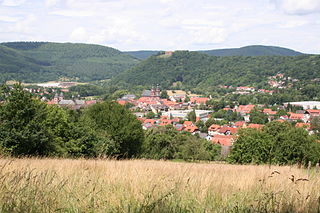
Amorbach is a town in the Miltenberg district in the Regierungsbezirk of Lower Franconia (Unterfranken) in Bavaria, Germany, with some 4,000 inhabitants. It is situated on the small river Mud, in the northeastern part of the Odenwald.

The University of Salzburg, also known as the Paris Lodron University of Salzburg, is an Austrian public university in Salzburg municipality, Salzburg State, named after its founder, Prince-Archbishop Paris Lodron.

Ettal Abbey is a Benedictine monastery in the village of Ettal close to Oberammergau and Garmisch-Partenkirchen in Bavaria, Germany. With a community of more than 50 monks, with another five at Wechselburg, the Abbey is one of the largest Benedictine houses and is a major attraction for visitors.
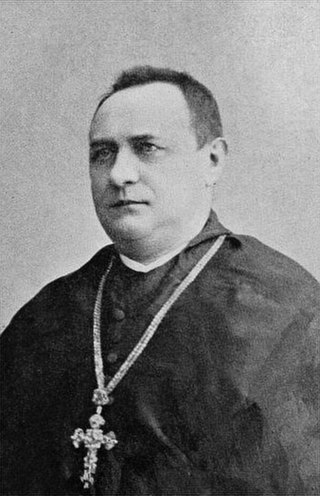
Leander (Franz) Czerny was an Austrian entomologist and priest. He was mainly interested in Diptera.

Spiridon Gopčević (junior), pen name Leo Brenner was a Serbian-Austrian astronomer and historian born in Trieste.
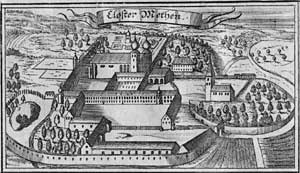
Metten Abbey, or St. Michael's Abbey at Metten is a house of the Benedictine Order in Metten near Deggendorf, situated between the fringes of the Bavarian Forest and the valley of the Danube, in Bavaria in Germany.
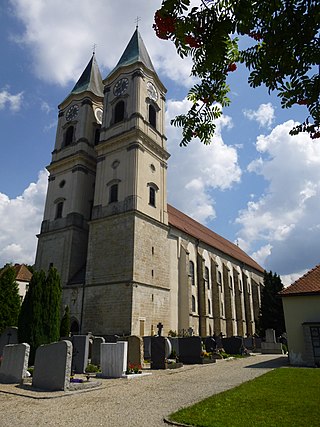
Niederaltaich Abbey is a house of the Benedictine Order founded in 741, situated in the village of Niederalteich on the Danube in Bavaria.

Kremsmünster Abbey is a Benedictine monastery in Kremsmünster in Upper Austria.

Göttweig Abbey is a Benedictine monastery near Krems in Lower Austria. It was founded in 1083 by Altmann, Bishop of Passau.

Admont Abbey is a Benedictine monastery located on the Enns River in the town of Admont, Austria. The oldest remaining monastery in Styria, Admont Abbey contains the largest monastic library in the world as well as a long-established scientific collection. It is known for its Baroque architecture, art, and manuscripts.

Garsten Abbey is a former Benedictine monastery located in Garsten near Steyr in Upper Austria. Since 1851, the former monastery buildings have accommodated a prison.
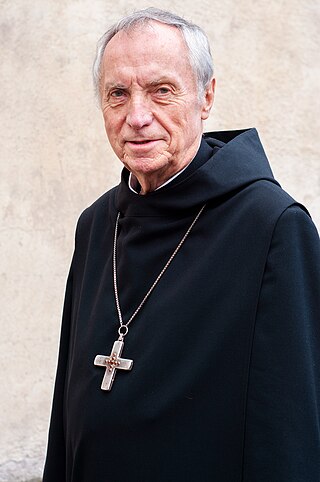
Notker Wolf is a German Benedictine monk, priest, abbot, musician, and author. He is a member of St. Ottilien Archabbey located in Bavaria, Germany, which is part of the Benedictine Congregation of Saint Ottilien. He previously was elected and served as the ninth Abbot Primate of the Benedictine Confederation of the Order of Saint Benedict. He was elected to his position as Abbot Primate in 2000 and ended his final term in 2016.

The Akademisches Gymnasium is a state gymnasium school located in Vienna, Austria. Founded by the Jesuits in March 1553, it is the oldest secondary school in Vienna and is now nondenominational and non-feepaying. The school offers a humanistic education and is known to be rather liberal compared to other traditional secondary schools in the city. Currently, there are approximately 600 pupils in 24 classes.

Maximilian Johann Karl Dominik Stadler, Abbé Stadler, was an Austrian composer, musicologist and pianist.

The Wachau is an Austrian valley with a picturesque landscape formed by the Danube river. It is one of the most prominent tourist destinations of Lower Austria, located midway between the towns of Melk and Krems that also attracts "connoisseurs and epicureans" for its high-quality wines. It is 36 kilometres (22 mi) in length and was already settled in prehistoric times. A well-known place and tourist attraction is Dürnstein, where King Richard I of England was held captive by Leopold V, Duke of Austria. The architectural elegance of its ancient monasteries, castles and ruins combined with the urban architecture of its towns and villages, and the cultivation of vines as an important agricultural produce are the dominant features of the valley.

Mark. H. Gelber is an American-Israeli scholar of comparative literature and German-Jewish literature and culture.
Hermine Haselböck is an Austrian mezzo-soprano in opera, concert and lied.

Arnoldstein Abbey was a Benedictine abbey in Arnoldstein in Carinthia, Austria. Its church was dedicated to St George and first mentioned in historical records in 1316 - its choir, tower, west door and a few buttresses can still be seen. The monastery buildings from the Gothic and 17th century eras were arranged around the church in an oval.

Franz Thürauer is an Austrian composer, music educator and church musician.






















